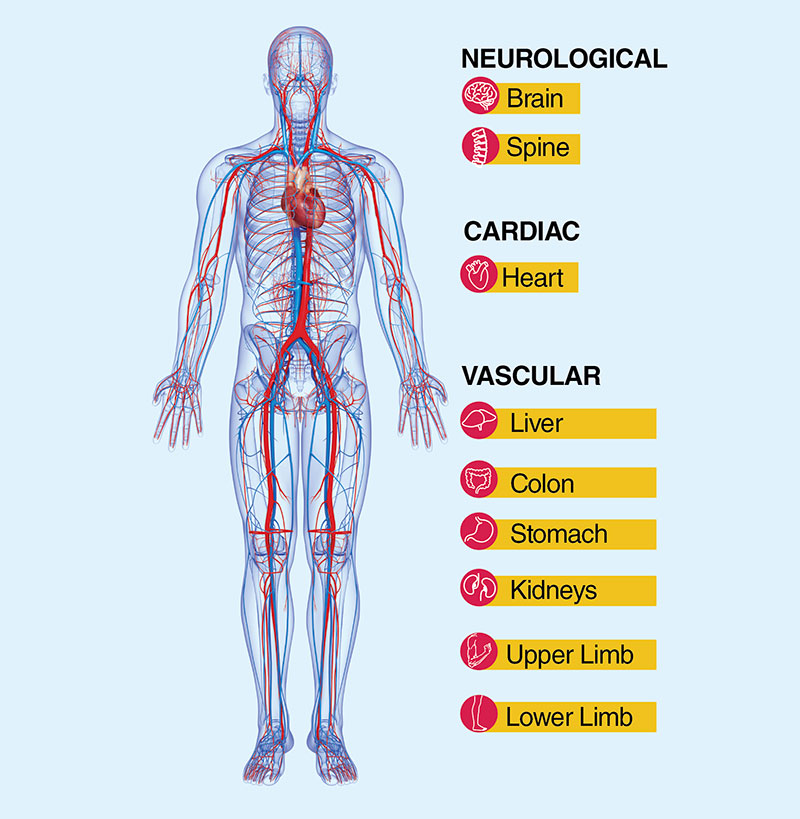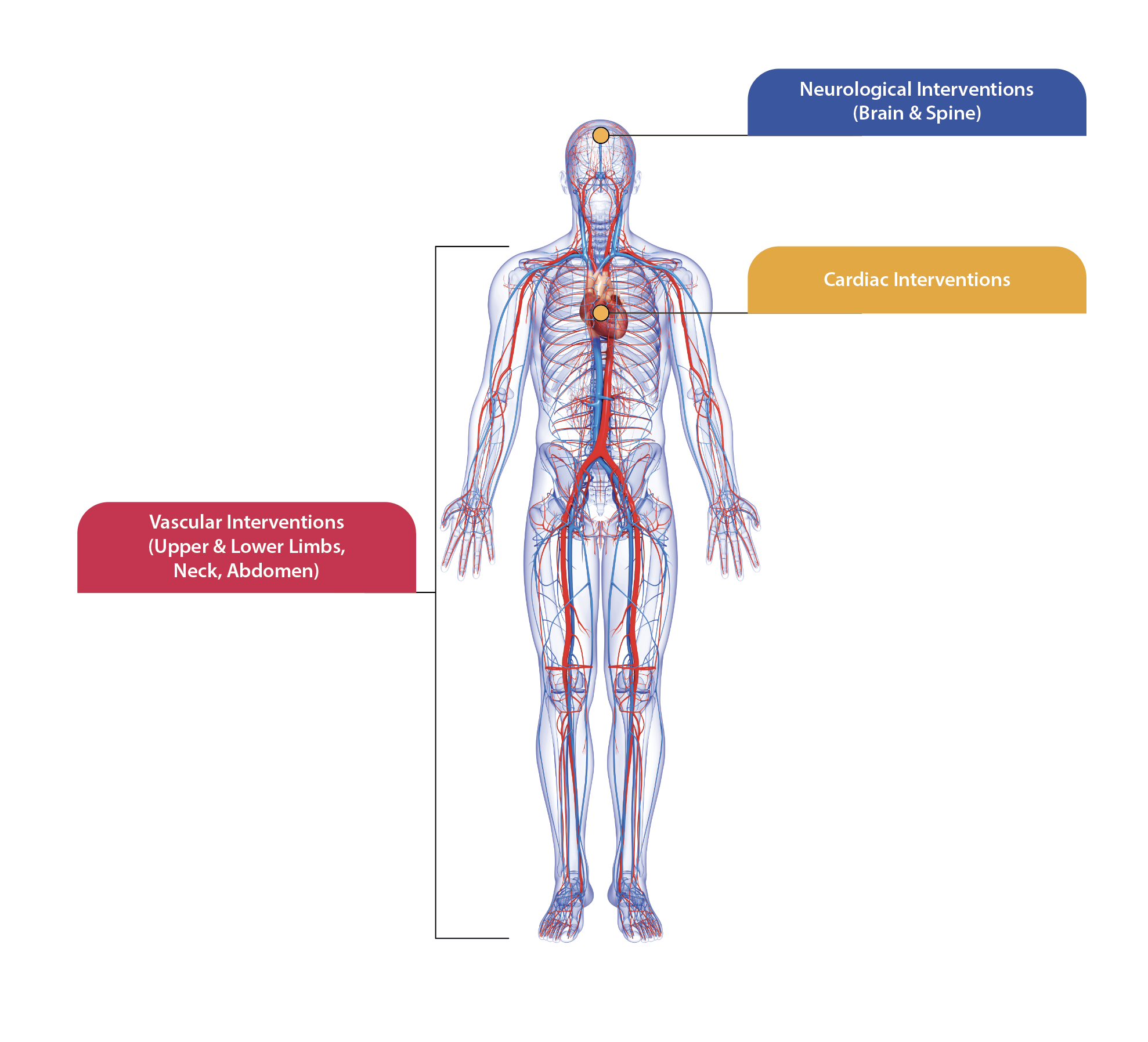Overview
The Department of Interventional Radiology uses minimally-invasive, image-guided procedures to diagnose and treat diseases of nearly every organ system. MIOT’s interventional radiologists perform Pinhole Surgery to treat a number of conditions including stroke, brain aneurysm, aortic aneurysms, uterine fibroid, tumour intervention, and Cancer and more.
IASIOS Accreditation

MIOT International is now the 1st hospital in India to receive IASIOS Accreditation, a prestigious global recognition for excellence in Interventional Oncology (IO). IASIOS is the world’s only accreditation focused on the quality and safety of cancer treatments by interventional radiologists. Developed by the European Society of Interventional Radiology, it evaluates the full patient journey from diagnosis to follow-up. To know more about IASIOS Accreditation in detail, visit: https://www.miotinternational.com/iasios/
A diagnostic and therapeutic speciality

No-incision procedures
Interventional radiology procedures are usually performed using needles and catheters that are as thin as a strand of hair. The interventional radiologist uses advanced imaging modalities to guide them to the diseased organ or area. The benefits to patient are many: less risk, physical trauma, and pain, fewer chances of infection, shorter hospital stay and a quicker recovery when compared to open surgery. Many conditions that once required open surgery are now treated by our interventional radiologists.
The Department has the latest state-of-the-art Biplane flat panel digital subtraction angiography unit with cone beam CT technology. We also have a radio-frequency ablation unit and a laser-ablation unit.

Vascular Interventions (Upper & Lower Limbs, Neck, Abdomen)
- Thyroid: FNA biopsy
- Liver: TACE (Transarterial Chemoembolization), TARE(Transarterial Radioembolization), TBD (Percutaneous Trans-hepatic Biliary Drainage)
- Upper limbs: Fistula Angioplasty
- Kidney: Nephrostomy/Embolization
- Lower limbs: Diabetic foot – Angioplasty, Varicose veins – Endovenous Ablation Therapy
- Aorta: SMA Angioplasty, Aortic stenting
- Anuerysm coilings
- AVM (Arterio-Venous Maltormation) Embolisation
- Endovascular Repair of Aortic Aneurysm
- Thoracic Endovascular Repair of Aorta
- Fenestrated Endovascular Aortic Repair
Neurological Interventions (Brain & Spine)
- Cerebral Angiography
- Aneurysm Coiling
- AVM Embolisation
- Stroke Management
- Tumor embolization
- Intracranial and carotid stenting
- Epistaxis bleeding control
- Dural AVF (Arteio-Venous Fistula) embolization
- Flow diverter for aneurysm
- Stent and ballon assisted coiling
- Sacral neuromodulation
Cardiac Interventions
- Coronary Angiography
- Cardiac Angioplasty
- Paediatric Cardiac Interventions
- Structural Heart & Valvular Interventions – TAVI(Transcatheter Aortic Valve Implantation), Pacemaker, Electrophysiology and Ablation
- IVUS – Intra vascular Ultrasound
- FFR/IFR – Fractional Flow Reserve
Treatments & Procedures
Vascular interventions:
- Genicular Artery Embolization (GAE)
- Lower limb and angioplasty/stenting (including subintimal and infrapopliteal angioplasty, SAFARI technique),
- Acute lower limb thrombolysis / mechanical thrombectomy
- Lower limb atherectomy procedures
- Upper limb angioplasty and stenting
- Aortic stent grafts for thoracic / abdominal aneurysmal disease and dissection
- Deep Vein Thrombosis- thrombolysis and venous stenting
- Haemodialysis access / central venous angioplasty, stenting, thrombolysis
- IVC filter insertion and removal
- Endovenous laser ablation for varicose veins
- Embolisation for vascular malformations.
Oncological interventions:
- Transarterial Chemo-embolisation (cTACE, bTACE, debTACE)
- Transarterial Radio-embolisation- TARE (Y90 spheres – Sirtex , Theraspheres)
- Portal vein embolisation
- Thermal ablation (radiofrequency/ microwave) of liver, kidney and lung tumours
- Cryoablation of renal and bone tumours
- Vertebroplasty / cementoplasty for augmentation of musculoskeletal tumours
- Palliative / pre-operative tumour embolisation
Liver Interventions:
- Biliary drainage, biliary stenting, biliary brush cytology
- Biliary stone removal
- Percutaneous cholecystostomy
- Transjugular portosystemic stent shunt (TIPSS)
- Hepatic Venous portal gradient measurement
- Liver and renal cancer radiofrequency (RF) /micro wave ablation
- Plug assisted retrograde Transvenous obliteration for gastric varices.
Thyroid:
Emergency interventions:
- Embolization for bleeding due to trauma, tumour,
- Embolization for bleeding from gastrointestinal tract,
- Embolization for haemoptysis
Genitourinary interventions:
- Nephrostomies and ureteric stenting
- Ureteric embolization for bleeding
- Prostate artery embolization for benign prostatic hyperplasia
- Testicular vein embolization for varicocoeles
- Fallopian tube recanalization for infertility
- Uterine artery embolization for fibroids, adenomyosis
- Ovarian vein embolisation for pelvic congestion syndrome
Gastrointestinal interventions:
- Radiological guided percutaneous gastrostomy / gastrojejunostomy insertion
- NJ tube insertion
- PARTO
- GI stenting
Venous access:
- PICC
- Tunneled and non tunneled central catheters for IV access or dialysis.
- Venous Ports
Biopsies and drainages:
- Image (CT/US/ PETCT) guided biopsies (including transjugular liver biopsy and bone lesions)
- Image guided fine needle aspiration of thyroid nodules, nodes.
- Image guided drainage of pleural effusion, ascites including long term Pleurex drains
- Intra-abdominal collections, liver / kidney/ psoas collections.
Meet the Doctors

Dr. Karthikeyan Damodharan
Director - Vascular & Interventional RadiologyDr Karthikeyan Damodharan is a well experienced vascular and interventional radiologist with over 15 years of specialist experience. Dr. Karthikeyan practices at MIOT International. Dr. Karthikeyan completed his MBBS from Madras Medical College in 2001. He did his post graduate training in the United Kingdom. He completed his MRCP (UK) in 2003 from the Royal College of Physicians, Edinburgh, FRCR (UK) in 2007 from the Royal College of Radiologists, London, FAMS in 2017 and European board certification in Interventional Radiology (EBIR) in 2019. He has done fellowship in vascular intervention at Leicester and further honed his skills by doing 1 year fellowship in advanced interventions at the prestigious Cleveland Clinic, USA.
Dr Karthikeyan Damodharan was invited to become a Fellow of the Interventional Radiology Society of Europe (FCIRSE) in 2019 based on his qualifications, experience and academic contribution in the field of Interventional radiology. He is a member of Indian Society of the vascular & interventional radiology (ISVIR), British Society of interventional radiology, Singapore Radiology society, Interventional radiology society of Singapore. He has published several articles in peer reviewed international journals and has been invited to speak at international radiology conferences.
He has worked as a consultant in the UK, senior consultant at Singapore before coming to India. He was the clinical lead for the interventional radiology service at Sengkang General Hospital in Singapore.
Some of the procedures performed include:
lower limb arterial and venous angioplasty/stenting/ thrombolysis, dialysis fistula angioplasty/ stenting/ thrombolysis, Laser ablation for varicose veins, IVC filter insertion/ retrieval, Liver and renal cancer radiofrequency (RF) /micro wave ablation, TACE (chemoembolization), Y90-TARE (radio embolization), TIPSS(transjugular intrahepatic stent shunt ), PARTO, uterine fibroid embolization, prostate artery embolization, CT and Ultrasound guided biopsies and drainages of collections.



